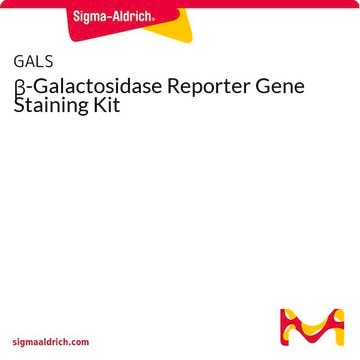GALA
β-Galactosidase Reporter Gene Activity Detection Kit
Sign Into View Organizational & Contract Pricing
All Photos(1)
About This Item
UNSPSC Code:
12352200
NACRES:
NA.32
Recommended Products
sterility
0.2 μm filtered
Quality Level
usage
kit sufficient for 65 tests
shipped in
dry ice
storage temp.
−20°C
Other Notes
The substrate used in this kit is o-nitrophenyl β-D-galactopyranoside (ONPG). ONPG generates a yellow color upon hydrolysis.
related product
Product No.
Description
Pricing
Signal Word
Warning
Hazard Statements
Precautionary Statements
Hazard Classifications
Skin Sens. 1
Storage Class Code
10 - Combustible liquids
Flash Point(F)
Not applicable
Flash Point(C)
Not applicable
Choose from one of the most recent versions:
Already Own This Product?
Find documentation for the products that you have recently purchased in the Document Library.
Claudia Massa et al.
The Biochemical journal, 407(2), 207-217 (2007-07-14)
We have recently isolated and heterologously expressed BcPeh28A, an endopolygalacturonase from the phytopathogenic Gram-negative bacterium Burkholderia cepacia. Endopolygalacturonases belong to glycoside hydrolase family 28 and are responsible for the hydrolysis of the non-esterified regions of pectins. The mode of action
Shaowei Wu et al.
International journal of molecular sciences, 17(4), 511-511 (2016-04-09)
Abrus cantoniensis (Hance) is a popular Chinese vegetable consumed as a beverage, soup or folk medicine. To fully exploit the potential of the polysaccharide in Abrus cantoniensis, nine polysaccharide fractions of Abrus cantoniensis were isolated and purified (AP-AOH30-1, AP-AOH30-2, AP-AOH80-1
V Hugouvieux et al.
Applied and environmental microbiology, 63(6), 2287-2292 (1997-06-01)
The production of endopolygalacturonase (endoPG) by Colletotrichum lindemuthianum, a fungal pathogen causing anthracnose on bean seedlings, was enhanced when the fungus was grown in liquid medium with L-arabinose or L-rhamnose as the sole carbon source. These two neutral sugars are
Ajaya K Biswal et al.
Biotechnology for biofuels, 10, 182-182 (2017-07-21)
The effective use of plant biomass for biofuel and bioproduct production requires a comprehensive glycosyl residue composition analysis to understand the different cell wall polysaccharides present in the different biomass sources. Here we compared four methods side-by-side for their ability
Current Protocols in Molecular Biology, Ch-Ch (1996)
Our team of scientists has experience in all areas of research including Life Science, Material Science, Chemical Synthesis, Chromatography, Analytical and many others.
Contact Technical Service








